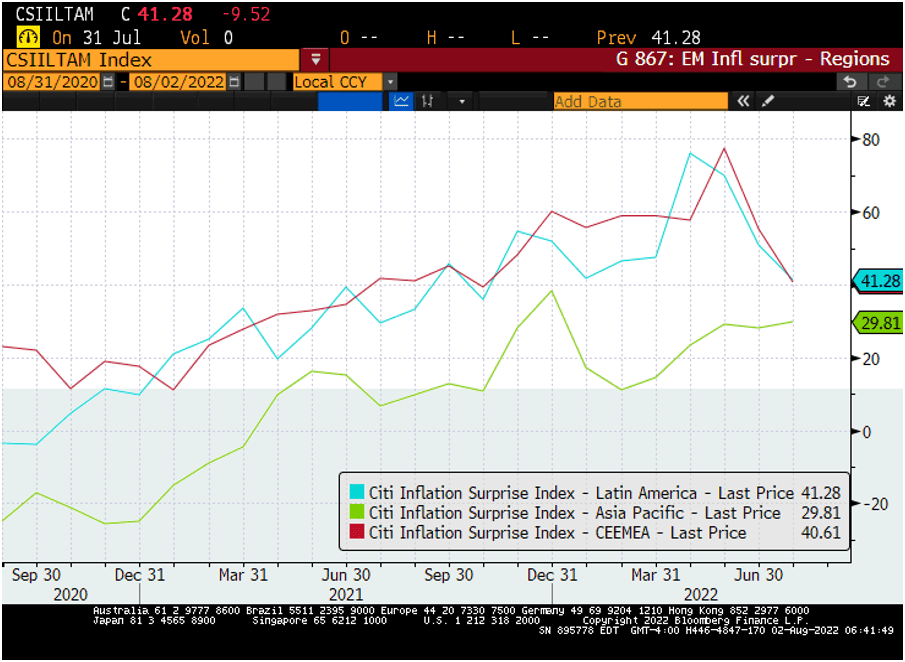2d illustrations and photos/iStock via Getty Images
Inflation surprises in EMEA/LATAM are heading south – a signal that peak hawkishness might be behind us and that central banks will focus more on growth headwinds going forward.
EM Inflation Pressures
The latest data releases in emerging markets (EM) Asia confirmed that peak inflation in the region remains elusive. Indonesia’s inflation surprised to the upside in July, accelerating to 4.94% year-on-year, and even though South Korea’s headline inflation was in line with expectations, it rose to 6.3% year-on-year. South Korean inflation is now 3 standard deviations higher than the 5-year trend, and this puts extra pressure on the central bank to keep on tightening beyond July’s 50bps policy rate hike (the market currently prices in additional 33bps in the next three months). Indonesia’s central bank had resisted policy normalization via rate hikes so far – playing with the reserve requirements for banks instead – but the Bloomberg consensus now sees a liftoff in Q3.
EM Peak Rates
Unlike EM Asia, inflation surprises in EMEA and LATAM are actually heading south (see chart below) – together with actual annual inflation in some countries. This includes the July print in Peru (eased to 8.74% year-on-year), and bi-weekly inflation in Brazil (eased to 11.39% year-on-year). Poland’s July inflation was stable for a change (still sky-high though at 15.5% year-on-year). This does not mean that tightening cycles will be cut short, but it does suggest that peak hawkishness in EMEA/LATAM might be behind us and that central banks will focus more on growth headwinds going forward.
Pace of Tightening In EM
There will be several important test cases – in all EM regions – in the next few days. India’s central bank meets on August 5 – the consensus sees a smaller hike (+38bps), following two larger moves (one of which was off-cycle) and measures to boost capital inflows. A 40-50bps hike would be a huge hawkish surprise. Brazil is expected to deliver another 50bps bps hike tomorrow, and then finalize the current cycle with a smaller 25bps hike in September. Finally, the Czech National Bank is meeting on Thursday – the consensus sees a small “conciliatory” hike (25bps), as a gesture not to scare the market after the dovish makeover of the board (the departing hawks “slammed the door” with a sizable “goodbye” rate hike). Stay tuned!
Chart at a Glance: Upside Inflation Surprises in EM Finally Fizzle Out – But Not Everywhere*
Bloomberg LP
*Citigroup Inflation Surprise Index (CISI), tracks whether a core set of inflationary data series has been coming in under expectations, at expectations, or over expectations.
PMI – Purchasing Managers’ Index: economic indicators derived from monthly surveys of private sector companies. A reading above 50 indicates expansion, and a reading below 50 indicates contraction; ISM – Institute for Supply Management PMI: ISM releases an index based on more than 400 purchasing and supply managers surveys; both in the manufacturing and non-manufacturing industries; CPI – Consumer Price Index: an index of the variation in prices paid by typical consumers for retail goods and other items; PPI – Producer Price Index: a family of indexes that measures the average change in selling prices received by domestic producers of goods and services over time; PCE inflation – Personal Consumption Expenditures Price Index: one measure of U.S. inflation, tracking the change in prices of goods and services purchased by consumers throughout the economy; MSCI – Morgan Stanley Capital International: an American provider of equity, fixed income, hedge fund stock market indexes, and equity portfolio analysis tools; VIX – CBOE Volatility Index: an index created by the Chicago Board Options Exchange (CBOE), which shows the market’s expectation of 30-day volatility. It is constructed using the implied volatilities on S&P 500 index options.; GBI-EM – JP Morgan’s Government Bond Index – Emerging Markets: comprehensive emerging market debt benchmarks that track local currency bonds issued by Emerging market governments; EMBI – JP Morgan’s Emerging Market Bond Index: JP Morgan’s index of dollar-denominated sovereign bonds issued by a selection of emerging market countries; EMBIG – JP Morgan’s Emerging Market Bond Index Global: tracks total returns for traded external debt instruments in emerging markets.
The information presented does not involve the rendering of personalized investment, financial, legal, or tax advice. This is not an offer to buy or sell, or a solicitation of any offer to buy or sell any of the securities mentioned herein. Certain statements contained herein may constitute projections, forecasts, and other forward-looking statements, which do not reflect actual results. Certain information may be provided by third-party sources and, although believed to be reliable, it has not been independently verified and its accuracy or completeness cannot be guaranteed. Any opinions, projections, forecasts, and forward-looking statements presented herein are valid as the date of this communication and are subject to change. The information herein represents the opinion of the author(s), but not necessarily those of VanEck.
Investing in international markets carries risks such as currency fluctuation, regulatory risks, economic and political instability. Emerging markets involve heightened risks related to the same factors as well as increased volatility, lower trading volume, and less liquidity. Emerging markets can have greater custodial and operational risks and less developed legal and accounting systems than developed markets.
All investing is subject to risk, including the possible loss of the money you invest. As with any investment strategy, there is no guarantee that investment objectives will be met and investors may lose money. Diversification does not ensure a profit or protect against a loss in a declining market. Past performance is no guarantee of future performance.
Editor’s Note: The summary bullets for this article were chosen by Seeking Alpha editors.


Be the first to comment